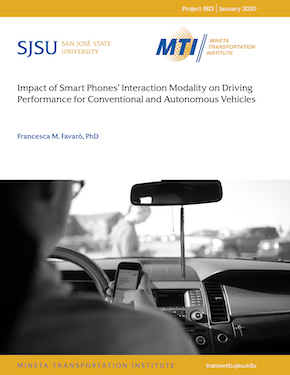- 408-924-7560
- mineta-institute@sjsu.edu
- Donate
Impact of Smart Phones’ Interaction Modality on Driving Performance for Conventional and Autonomous Vehicles
Distracted driving related to cell phone usage ranks among the top three causes of fatal crashes on the road. Although forty-eight U.S. states currently allow the use of personal devices if operated hands-free and secured in the vehicle, scientific studies have yet to quantify the safety improvement presumed to be introduced by voice-to-text interactions. This study investigates how different modes of drivers' interaction with a smart phone (i.e., manual texting vs. vocal input) affect drivers’ distraction and performance in both conventional and semi-autonomous vehicles. The study was executed in a full-car integrated simulator with a sample size of 32 drivers. The study considered two scenarios: (1) conventional manual driving in a suburban environment with intersection stops; and (2) control takeover from an engaged autonomous vehicle that reverted to manual driving at a highway exit. The quality of execution of maneuvers as well as timing and tracking of eye-gaze focus areas were assessed in both scenarios. Results demonstrated that while participants perceived an increased level of safety while using the hands-free interface, response times and drift did not significantly differ from those manually texting. Furthermore, even though participants perceived a greater effort in accomplishing the text reply through the manual interface, none of the measured quantities for driving performance or eye-gaze focus revealed statistical difference between the two interfaces, ultimately calling into question the assumption of greater safety implicit in the laws allowing hands-free devices.
FRANCESCA M. FAVARÒ
Dr. Favarò is an Assistant Professor in the Department of Aviation and Technology in the College of Engineering at San José State University. Prior to joining SJSU, she earned a PhD and MS in Aerospace Engineering at the Georgia Institute of Technology and an MS and BS in Space Engineering at Politecnico di Milano, Italy. Dr. Favarò’s research interests lie in the broad field of system safety and risk analysis, with an emphasis on system engineering concepts and the safe integration and embedding of new technologies and the consistent update of regulations and certification practices. In 2016, she funded the RiSA2S lab, which deals with Risk and Safety Assessment of Autonomous Systems such as unmanned aircraft systems and self-driving cars. In 2017 she became an MTI research associate and started collaborating as an expert in the realm of autonomous vehicles. Her interests are currently focused on the safe integration of autonomous systems within U.S. public roads as well as national airspace. She particularly focuses on bridging the gap between the technological world and the current regulatory panorama. Dr. Favarò has authored several journal publications and conference proceedings on a variety of topics, ranging from UAS mishaps to risk assessment and regulatory compliance for nuclear power plants. Dr. Favarò serves on the Board of Directors of the Aero Club of Northern California and acts as Secretary for CAAPSO (Community and Airport Partnership for Safe Operations), an aviation interest group that safeguards safe and efficient operations at the local airport of Reid-Hillview, San José. She is an FAA-certified Advanced Ground Instructor, a certified Remote Pilot for UAS commercial operations, and a solo-endorsed pilot.
-
Contact Us
San José State University One Washington Square, San Jose, CA 95192 Phone: 408-924-7560 Email: mineta-institute@sjsu.edu






